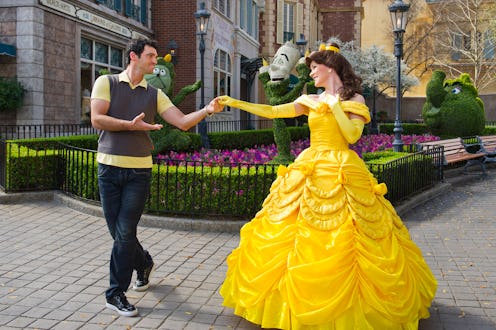Life
Why Do We Obsess Over Disney Princesses?
This week brings news of a high school junior from Virginia who created a Change.org petition calling for Disney to create a plus-size princess, which now has over 10,000 signatures. I love this idea, but it isn't a standalone occurrence. It's just the latest in what seems like a cultural obsession with Disney princesses — in the age of the Internet, commenting on, spoofing, analyzing, and remixing Disney princesses is like its own sub-genre. From dressing them in modern clothes, to clothes in style the year their movie came out, to period-appropriate costumes, these ladies get make overs a lot. Or, in some cases, get ludicrously "un-made over." Other manipulations are more political, like Disney princesses with disabilities. And then some, like College Humor's " Tinderella" might have any number of messages, depending on how you look at it, but mostly they're just really funny.
So what gives? Why are Disney princesses still a big deal? I mean, Snow White came out in 1937 for God's sakes. Why is she still relevant to us, more than 75 years later?
It's because Disney princesses are a loaded thing for women and girls in our society. Disney movies are seen by pretty much all children, and there's a whole industry built around these characters: toys and story books and costumes and on and on. And somewhere between being told to watch them and dress up like them, we often get the idea that we are supposed to be like them. Little girls are encouraged to think of themselves as princesses. Disney princesses are our first "role models," after maybe our parents.
It is for this reason that issues of racism and sexism and body image in Disney films are a big deal. It is for this reason that we complain when the waists of Disney princesses are thinner than their heads. All of the messages that Disney sends seep into the brains of little girls and become part of their first conception of who they want to be.
As a kid, I always wanted to be Belle, because she reads, and she got to be friends with talking furniture, which was pretty cool. And looking back, I think that choice was at least partly my own defense against the other, far less interesting options I was faced with. But even Belle, when you think about it, essentially has Stockholm Syndrome. So maybe she wasn't such a great role model after all.
The fact that Disney princesses are such a huge part of our early conception of ourselves means that when we grow up, long after we have outgrown our princess faze, Disney princesses continue to fascinate. And so people try to manipulate their images or their stories or their identities in a way that befits our post-child lives, and we continue to view those efforts with continued interest.
In some ways, modifying Disney princesses is a way of fighting back against that initial pressure to be a princess. Because even if there's a little girl in America who never went through a princess phase, I'd be surprised if there's one who never felt the princess-pressure closing in from all sides. So putting them in wheelchairs or giving them a hook-up app is a way of reclaiming the narrative.
Even redone princess images that don't have an obvious angle — like putting the princesses in the clothes that were in style when their movies came out — are a way of pushing back. We break the princesses out of their narrow roles, show that they don't have to be exactly as they are in the movies. And in this way we reclaim them, and by extension ourselves. Because if the world thinks we all ought to be princesses, fine, but we're going to decide what princess are. And you can't stop us.
